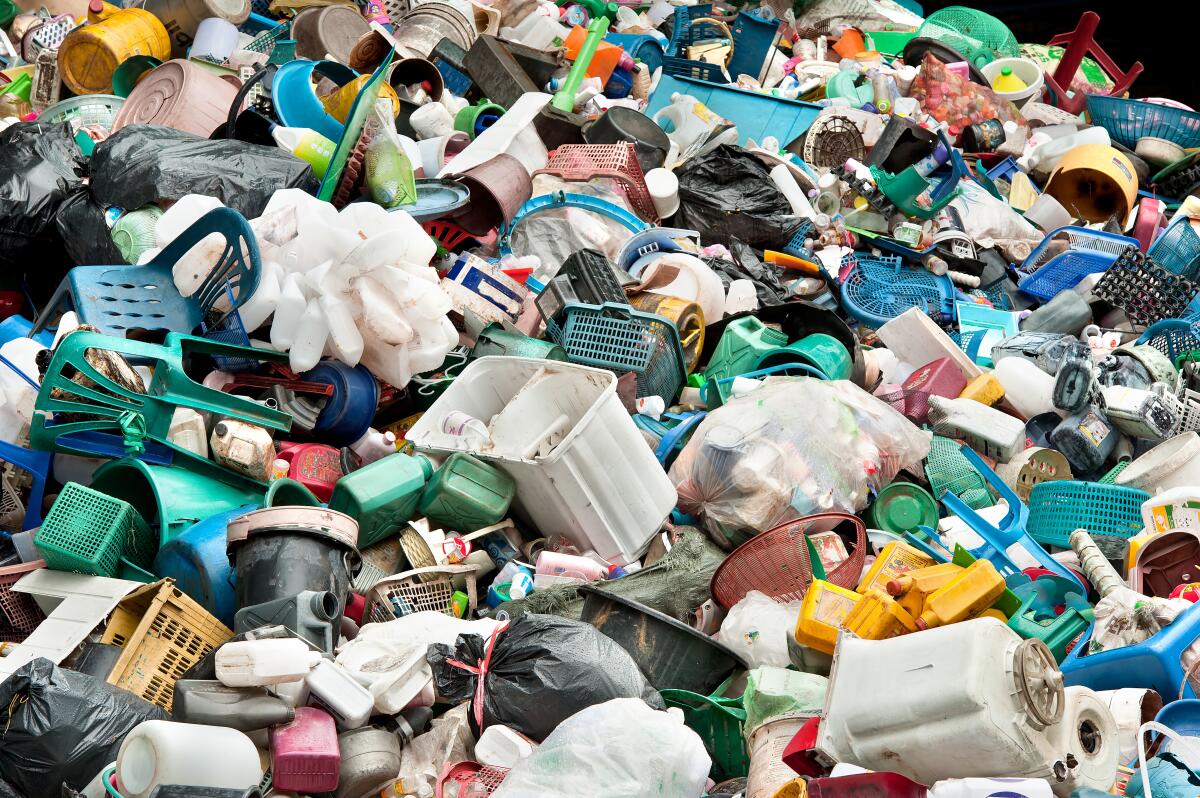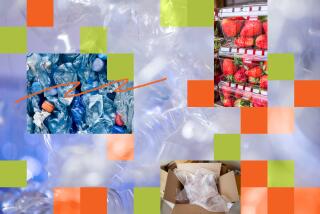Opinion: Microplastics are getting into our bodies. We need to understand what that means

- Share via
Nobody wants to snack on plastic bags or soda rings, but according to a 2019 study from the University of Newcastle, we could be consuming roughly a credit card’s worth of plastic every week.
Microplastics, which are less than a quarter-inch in size and come in various shapes and textures, have contaminated the natural world and infiltrated our bodies. These particles are just about everywhere on Earth, including in drinking water and the air we breathe, but until recently we didn’t know how ubiquitous they really were.
Microplastics were first discovered in our oceans, and the vast majority of studies published since then focus on marine environments only. The threat to our oceans is indeed huge, but it’s not the full picture anymore.
The first clue to microplastic exposure in humans came around 2013, when scientists discovered plastic particles in seafood prepared for consumption. But by 2019, when the University of Newcastle study was published, the scientific community understood that the problem was considerably broader.
“We started to realize that we have exposure that’s much greater than just a fish at the grocery store,” said Dr. Chelsea Rochman, a University of Toronto professor who helped produce a report on microplastics in April for the California Ocean Science Trust. “The trend of the research at first was just to show that we were exposed, and then it became clear that we needed to understand how this impacts human health.”
Microplastics shed off of clothes and tires and have been found in beer, honey, table salt and other food items. We inhale plastic suspended in the air and drink plastic floating in our beverages. It’s no stretch to conclude that our exposure is significant. What we don’t know is what this means for us.
Researchers started to look seriously into the human health impacts of microplastic ingestion and inhalation just a few years ago. We’ve started to ask the right questions, but there’s a long way to go. If we’re going to get the answers in time, we need to prioritize this area and funnel resources into science that analyzes how microplastics interact with our bodies.
The amount of evidence collected on this subject is growing rapidly, according to Scott Coffin, a toxicologist also involved with the state report. Studies done on mice and rats have found that plastic contamination can reduce fertility, alter the gut microbiome and cause oxidative stress, which can severely damage cells.
These results aren’t directly translatable to people, however, and there are gaps in the research that make it difficult to draw conclusions. Most studies rely on polystyrene spheres, a specific kind of microplastic that can be purchased commercially but doesn’t reflect the vast range of plastics and chemicals in the natural environment.
Susanne Brander, an Oregon State University professor who also worked on the recent report, acknowledges these shortcomings. “More studies are needed on environmentally relevant plastic types before we can say with full confidence that the plastics you’re exposed to every day could harm you in these ways,” Brander said. “But I think it’s safe to say that it’s a concern, and if we’re seeing responses in mouse models, it’s likely that humans are also being affected.”
Toxicologists, ecologists and other scientists have been digging deep into these questions, but the scientific process is still in its infancy. Meanwhile, major environmental agencies such as the Environmental Protection Agency and National Science Foundation have not provided funding for microplastic research regarding human health.
We already know enough to take action on the microplastics problem, but without all the details, it’s much more challenging to bring about change. If we could bring specifics to the table — for example, that these plastics cause cancer, damage organs, reduce fertility — there would be more pressure on public officials to pass sweeping regulations.
“We have to make a bit of a leap and say, whatever’s happening in rodents is happening at similar quantities in humans,” Coffin said, “and there is a little bit of a precautionary principle baked into that assumption.”
But will we be willing to make that leap? Because microplastics are too small to clean up, the only solution is to stop plastic waste at the source. And doing so would take a radical adjustment, given that plastics are deeply embedded in our economy and lifestyle. Weaning ourselves from them would fundamentally affect countless industries, including textiles, transportation and manufacturing.
“I think we’re going to need to have more studies coming out that are directly related to human health before we see a lot more concern from the general public,” Brander said. “It takes a lot to convince people that something that is really convenient for them to use is something they should sacrifice.”
The question of microplastics and human health needs more attention — from the scientific community, the general public, the government and funding groups. The issue isn’t being ignored, but it’s not being prioritized either.
In a perfect world, the knowledge we have now would be enough impetus for policy change. But in a society stuck in its ways and reluctant to alter the status quo, we need more than precaution to move the needle.
More to Read
A cure for the common opinion
Get thought-provoking perspectives with our weekly newsletter.
You may occasionally receive promotional content from the Los Angeles Times.











